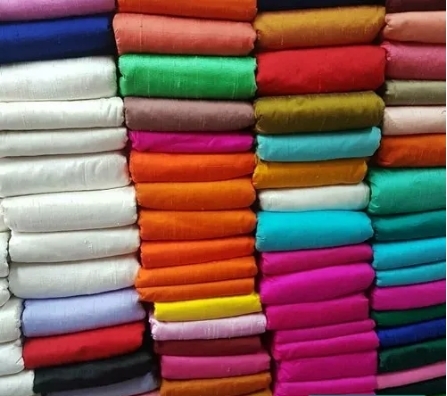More than 67% of Vietnam's garment fabrics are imported from Chinese market
Thursday, November 7,2024
AsemconnectVietnam - In the first 9 months of 2024, China continued to be the largest market supplying garment fabrics to Vietnam, accounting for more than 67% of total import turnover of this item.
According to preliminary statistics from General Department of Customs, import turnover of various garment fabrics into Vietnam in the first 9 months of 2024 was worth nearly 10.95 billion USD, an increase of 14.3% compared to the first 9 months of 2023.
September 2024 alone reached over 1.25 billion USD, an increase of 1.2% compared to August 2024 and an increase of 14% compared to September 2023.
Up to 67% of total turnover of imported garment fabrics to Vietnam originated from the Chinese market. In September 2024 alone, imports from this market reached over 802.29 million USD, down 4.1% compared to August 2024 but up 10.8% compared to September 2023; total for the first 9 months of 2024 reached over 7.33 billion USD, up 20.4% compared to the first 9 months of 2023.
Followed by Taiwan market (China) reached nearly 1.14 billion USD, up 11.6%, accounting for 10.4%; In September 2024 alone, it reached 152.66 million USD, up 9.6% compared to August 2024 and up 20.6% compared to September 2023.
Imports from Korean market in September 2024 increased by 1.4% compared to August 2024 and increased by 2.1% compared to September 2023, reaching over 113.64 million USD; in the first 9 months of 2024, it decreased by 0.5% over the same period, reaching over 1.11 billion USD, accounting for 10.2%. Fabric imported from Japanese market in the first 9 months of 2024 decreased by 4.1%, reaching 478.97 million USD, accounting for 4.4%.
In general, import turnover of garment fabrics from most markets in the first 9 months of 2024 increased compared to the first 9 months of 2023.
Fabric is an extremely important input material for the Vietnamese textile and garment industry - this is a key industry with an export turnover of tens of billions of USD each year. Currently, Vietnamese garment products have been exported to 104 countries and territories. However, domestic raw fabric sources only meet 50% of demand, so Vietnam has to import raw fabric materials from other countries, typically China.
Chinese fabrics are so popular that traders from Europe have flocked to port to import them, creating the famous "Silk Road" connecting regions of China to Mongolia, India, Afghanistan, Kazakhstan, Iran, Iraq, Turkey, Greece, around the Mediterranean and all the way to Europe.
China's advantages in textile industry are low production costs, quality raw materials, modern industrial infrastructure and available high-tech machinery, making this market always a priority for other countries to import. Currently, textile and garment factory clusters in China are concentrated in the eastern coastal provinces, in Zhejiang, Jiangsu, Guangdong, Fujian, Shandong, and Hebei.
Not only accounting for a large number of the world's textile and garment output, many textile and garment establishments in China are also actively shifting to applying automation to production lines to improve productivity and avoid labor shortages.
For silk, China's new generation of silkworms produces white silk, so there is no need to bleach, helping the silk to achieve better quality. China's new generation of silkworms also produces longer cocoons, without breaking, and silk productivity is much higher than other countries.
Source: Vitic/ congthuong.vn
September 2024 alone reached over 1.25 billion USD, an increase of 1.2% compared to August 2024 and an increase of 14% compared to September 2023.
Up to 67% of total turnover of imported garment fabrics to Vietnam originated from the Chinese market. In September 2024 alone, imports from this market reached over 802.29 million USD, down 4.1% compared to August 2024 but up 10.8% compared to September 2023; total for the first 9 months of 2024 reached over 7.33 billion USD, up 20.4% compared to the first 9 months of 2023.
Followed by Taiwan market (China) reached nearly 1.14 billion USD, up 11.6%, accounting for 10.4%; In September 2024 alone, it reached 152.66 million USD, up 9.6% compared to August 2024 and up 20.6% compared to September 2023.
Imports from Korean market in September 2024 increased by 1.4% compared to August 2024 and increased by 2.1% compared to September 2023, reaching over 113.64 million USD; in the first 9 months of 2024, it decreased by 0.5% over the same period, reaching over 1.11 billion USD, accounting for 10.2%. Fabric imported from Japanese market in the first 9 months of 2024 decreased by 4.1%, reaching 478.97 million USD, accounting for 4.4%.
In general, import turnover of garment fabrics from most markets in the first 9 months of 2024 increased compared to the first 9 months of 2023.
Fabric is an extremely important input material for the Vietnamese textile and garment industry - this is a key industry with an export turnover of tens of billions of USD each year. Currently, Vietnamese garment products have been exported to 104 countries and territories. However, domestic raw fabric sources only meet 50% of demand, so Vietnam has to import raw fabric materials from other countries, typically China.
Chinese fabrics are so popular that traders from Europe have flocked to port to import them, creating the famous "Silk Road" connecting regions of China to Mongolia, India, Afghanistan, Kazakhstan, Iran, Iraq, Turkey, Greece, around the Mediterranean and all the way to Europe.
China's advantages in textile industry are low production costs, quality raw materials, modern industrial infrastructure and available high-tech machinery, making this market always a priority for other countries to import. Currently, textile and garment factory clusters in China are concentrated in the eastern coastal provinces, in Zhejiang, Jiangsu, Guangdong, Fujian, Shandong, and Hebei.
Not only accounting for a large number of the world's textile and garment output, many textile and garment establishments in China are also actively shifting to applying automation to production lines to improve productivity and avoid labor shortages.
For silk, China's new generation of silkworms produces white silk, so there is no need to bleach, helping the silk to achieve better quality. China's new generation of silkworms also produces longer cocoons, without breaking, and silk productivity is much higher than other countries.
Source: Vitic/ congthuong.vn
Import and export turnover in 10 months reached nearly 650 billion USD
Import and export taxes on fertilizers and tobacco to be changed
Vietnam's pangasius export to Canada increase again
Vietnam-China two-way trade approaching 150 billion USD
Imports of electronics, computers and components are forecast to reach a historic milestone of 100 billion USD
Seafood exports in October returned to 1 billion USD after 27 months
Vietnam's agricultural, forestry and fishery exports in October and 10 months of 2024
From which market does Vietnam import the most pharmaceuticals?
9 months, rubber export earned 2.18 billion USD
Earning billions of USD from export, pangasius still faces great risks
Leading groups of goods with export turnover of tens of billions USD
Pangasius export turnover in 9 months is estimated at nearly 1.5 billion USD
Commodity export to reach a historic milestone of about 400 billion USD
Agricultural, forestry and fishery exports in 2024 may exceed 60 billion USD

Plan of Hai Duong province for a period of 2021 - 2030, ...
Organize space reasonably and harmoniously, focusing on connecting Hai Duong in common development space, actively contributing to the ...Plan of Hau Giang province in a period of 2021 - 2030, ...
Sustainable forestry development program in a period of ...

Women’s seven-a-side football tournament to make national ...
Women’s seven-a-side football tournament to make national debut Vietnam will for the first time have an official seven-a-side football ...Vietnam advance to semifinals of ASEAN Futsal Championship
Vietnam int’l fashion week Fall/Winter 2024 to open


